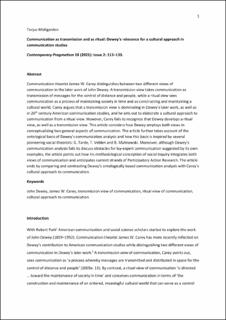Communication as Transmission and as Ritual: Dewey’s Account of Communication and Carey’s Cultural Approach
Journal article, Peer reviewed
Accepted version
Permanent lenke
https://hdl.handle.net/11250/2984624Utgivelsesdato
2021Metadata
Vis full innførselSamlinger
Originalversjon
Contemporary Pragmatism. 2021, 18 (2), 113-133. https://doi.org/10.1163/18758185-bja10008Sammendrag
Communication theorist James W. Carey distinguishes between two different views of communication in the later work of John Dewey. A transmission view takes communication as transmission of messages for the control of distance and people, while a ritual view sees communication as a process of maintaining society in time and as constructing and maintaining a cultural world. Carey argues that a transmission view is dominating in Dewey’s later work, as well as in 20th century American communication studies, and he sets out to elaborate a cultural approach to communication from a ritual view. However, Carey fails to recognize that Dewey develops a ritual view, as well as a transmission view. This article considers how Dewey employs both views in conceptualizing two general aspects of communication. The article further takes account of the ontological basis of Dewey’s communication analysis and how this basis is inspired by several pioneering social theorists: G. Tarde, T. Veblen and B. Malinowski. Moreover, although Dewey’s communication analysis fails to discuss obstacles for lay-expert communication suggested by its own examples, the article points out how his methodological conception of social inquiry integrates both views of communication and anticipates current strands of Participatory Action Research. The article ends by comparing and contrasting Dewey’s ontologically based communication analysis with Carey’s cultural approach to communication.
